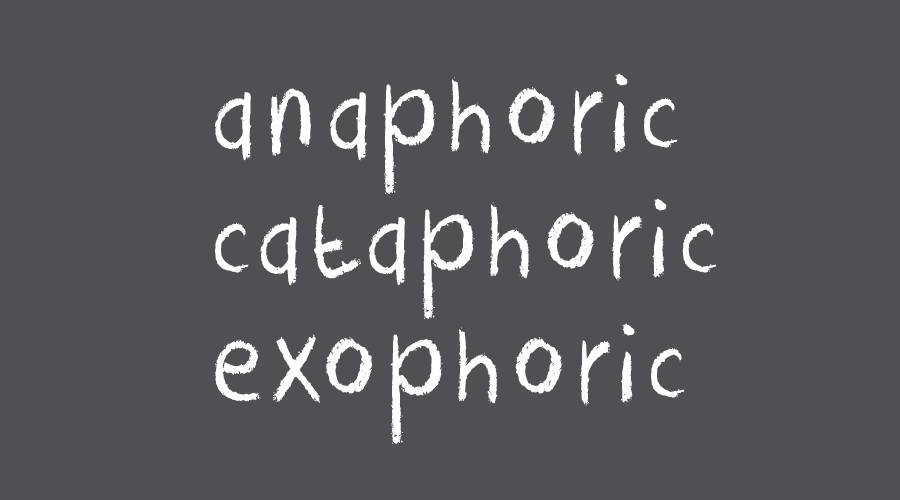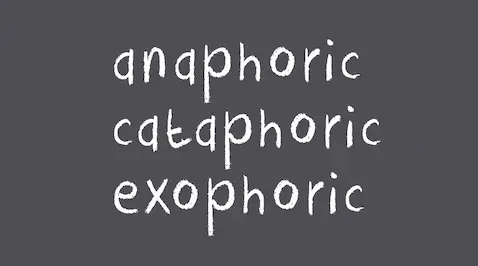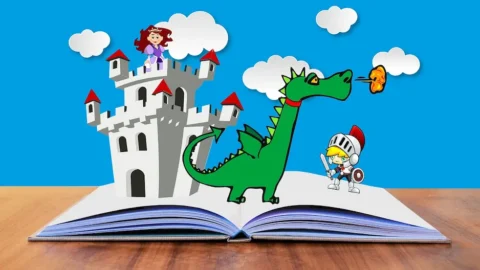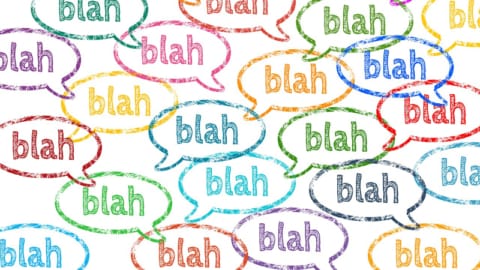When we speak or write we often refer to things that were mentioned earlier, haven’t been mentioned yet, or were mentioned in another context or at another time.
What is anaphoric reference?
Anaphoric reference occurs when a word or phrase refers to something mentioned earlier in the discourse.
Here’s an example of anaphoric reference:
- Michael went to the bank. He was annoyed because it was closed.
He refers to Michael.
it refers to the bank.
Anaphoric reference often makes use of the definite article the, because one of the functions of the definite article is to indicate that something has already been mentioned. Here’s another example:
- He sat down at the table and took a small box from his pocket. The object felt heavy in his hands. Inside it was the key to his future.
Both the object and it refer back to a small box in the first sentence.
What is cataphoric reference?
Cataphoric reference occurs when a word or phrase refers to something mentioned later in the discourse.
Here are some examples of cataphoric reference:
- Although I phone her every week, my mother still complains that I don’t keep in touch often enough.
Her refers to my mother.
- The book was there on the table. I’d never read Moby Dick and I didn’t intend to do so now.
The book refers to Moby Dick.
What is exophoric reference?
Exophoric reference occurs when a word or phrase refers to something outside the discourse.
Here are some examples of exophoric reference:
- “They‘re late again, can you believe it?”
“I know! Well, they’d better get here soon or it‘ll get cold.”
They refers to some people outside the discourse known to both speakers.
It also refers to something that both speakers know about (perhaps the dinner).
The use of exophoric reference requires some shared knowledge between two speakers, or between writer and reader(s).








35 comments
Luis
I am studing English (traductor de Inglés) and this article really helped me understand the concepts. It is very clear and the examples clarify the explanations.
Keith Taylor
Hi Luis – thanks for your comment, I’m glad the article is useful for you!
Safaa Imad
Thank you so much
It’s really helpful
Many other articles I have read were no use
Aseelkh
Hey!
When does the Endophoric Reference occur? Is it when a word refers to something inside the discourse?
Keith Taylor
Hi Aseelkh
Thanks for your question. “Endophoric” reference is a more general term that includes both anaphoric and cataphoric reference. So it refers to something inside the text, either earlier (anaphoric) or later (cataphoric).
I hope that helps.
Aseel Khalil
Good Afternoon!
Thanks for replying!
Okay, I see. It seems obvious to me now, Thanks very much :)
Aseel Khalil
Excuse me, I have one more question about the anaphoric Reference
I couldn’t get the point about the function of the definite article.
Could you please explain that to me?
Keith Taylor
The definite article is the word “the”. We often use the word “the” to refer to something that we’ve already talked about, and so this makes it a very useful word for anaphoric reference (referring to something earlier in the discourse).
I hope this helps.
Samah Bastawy
Thanks a lot, I am studying discourse analysis, it is a branch of linguistics study. Definitely this is a very useful explanation.
Justice
Very concise. Loved it
Olamide
Found it really useful
Mtshi404
This came in very handy for an assignment I was doing. Thank you.
Keith Taylor
Glad it was a help!
Paul Brandy MUKENYI
Your article’s really interesting for people reading linguistics.
mapaseka sefate
Thank you this really helped me
Moses Kingsley Arthur
Thanks very much for your explanations on the types of referencing. I’m grateful.
*Can you please give some examples of endophoric referencing?*
Once again, thank you.
Keith Taylor
Hi Moses
“Endophoric” reference is a more general term that includes both anaphoric and cataphoric reference. So it refers to something inside the text, either earlier (anaphoric) or later (cataphoric). So any of the examples above of anaphoric and cataphoric reference are also examples of endophoric reference.
Hope that helps.
Kenewa Gamanga
The clarity together with the simple language that you use in your responses is commendable. Your resilience and courage to reply underscores the virtues of a professional teacher. Thanks.
Mrs Kusi
This article has given me clarification on the topic.
Thank you.
Khajas
Please answer my question…can an exophoric reference be an anaphoric in the same time with example please
Hikari
Hey! I’ve a question: Can an anaphora be considered as an exophora? If yes how?
Keith Taylor
Hi Khajas and Hikari
I don’t think this is possible.
Anaphoric reference = referring to something earlier in the discourse
Exophoric reference = referring to something outside the discourse
By definition, if something appears earlier in the discourse, it isn’t outside the discourse.
Mukole
Thanks for these references, they can easily be understood
Noela Nzuyu
Thank you very much. This article has given me more clarification about the topic.
Ahmad Auwal Gwangwazo
Thanks for your writeup. I’ve absolutely learnt a lot from it. More power to your elbow.
However, I’d really like you to provide me with copious examples of exophoric reference to dust the dirt. Though I got it, I didn’t catch it pretty much.
AKOR OGBONNA BOLUWATIFE
Now I understand the difference between endophoric and exophoric reference. Thanks for this comprehensive analysis.
Yadeta Hambissa
Actually it is very interesting. I liked it.
Kaosarah Adebukola
It is really effective and useful
Katia AMIR
Very interesting article and it really helps me to understand the difference between endophoric and cataphoric references.
Thank you so much.
Fatimah
Really helpful !:) wish my teacher could teach in the same way btw thanks so much.
Meow
Thank you for this. I was confused but now this article has cleared my doubts. Thanks again!
Clinton Kambole
Good afternoon. What example can qualify under endophoric type of reference?
Keith Taylor
Hi Clinton
Endophoric reference is a more general term that includes both anaphoric and cataphoric reference. So it refers to something inside the text, either earlier (anaphoric) or later (cataphoric).
Hope that helps.
Hana
Can you help me with this question,Sir?
Dave: I think phubbing is getting worse now. People tend to ignore others during conversations almost on all occasions.
Prilly: You are right. In my opinion this action interrupts their ability to be present and engage with people around them.
Dave: That’s true. I guess it causes a bad impact to the phubber’s mental health. One study found that texting during a face to face conversation made the experience less satisfying for everyone involved. Even the guilty phubber. Do you have other opinions?
Prilly: A research I read states that spouses who phub each other experience higher rates of depression and it can cause more serious problems in the family.
Dave: It must be nice if people can live without problems.
The exophoric reference found in the conversation is…
Keith Taylor
Hi Hana – I can’t see an exophoric reference in this conversation. Have you seen one?